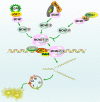Role of MCM2-7 protein phosphorylation in human cancer cells
- PMID: 30062004
- PMCID: PMC6056998
- DOI: 10.1186/s13578-018-0242-2
Role of MCM2-7 protein phosphorylation in human cancer cells
Abstract
A heterohexameric complex composed of minichromosome maintenance protein 2-7 (MCM2-7), which acts as a key replicative enzyme in eukaryotes, is crucial for initiating DNA synthesis only once per cell cycle. The MCM complex remains inactive through the G1 phase, until the S phase, when it is activated to initiate replication. During the transition from the G1 to S phase, the MCM undergoes multisite phosphorylation, an important change that promotes subsequent assembly of other replisome members. Phosphorylation is crucial for the regulation of MCM activity and function. MCMs can be phosphorylated by multiple kinases and these phosphorylation events are involved not only in DNA replication but also cell cycle progression and checkpoint response. Dysfunctional phosphorylation of MCMs appears to correlate with the occurrence and development of cancers. In this review, we summarize the currently available data regarding the regulatory mechanisms and functional consequences of MCM phosphorylation and seek the probability that protein kinase inhibitor can be used therapeutically to target MCM phosphorylation in cancer.
Keywords: Cell cycle; Checkpoint response; DNA replication; MCM; Phosphorylation.
Figures


Similar articles
-
Clb/Cdc28 kinases promote nuclear export of the replication initiator proteins Mcm2-7.Curr Biol. 2000 Feb 24;10(4):195-205. doi: 10.1016/s0960-9822(00)00337-7. Curr Biol. 2000. PMID: 10704410
-
Plant MCM proteins: role in DNA replication and beyond.Plant Mol Biol. 2011 Dec;77(6):537-45. doi: 10.1007/s11103-011-9836-3. Epub 2011 Oct 25. Plant Mol Biol. 2011. PMID: 22038093 Review.
-
Kaposi's Sarcoma-Associated Herpesvirus Deregulates Host Cellular Replication during Lytic Reactivation by Disrupting the MCM Complex through ORF59.J Virol. 2018 Oct 29;92(22):e00739-18. doi: 10.1128/JVI.00739-18. Print 2018 Nov 15. J Virol. 2018. PMID: 30158293 Free PMC article.
-
Post-Translational Modifications of the Mini-Chromosome Maintenance Proteins in DNA Replication.Genes (Basel). 2019 Apr 30;10(5):331. doi: 10.3390/genes10050331. Genes (Basel). 2019. PMID: 31052337 Free PMC article. Review.
-
Nascent transcription of MCM2-7 is important for nuclear localization of the minichromosome maintenance complex in G1.Mol Biol Cell. 2007 Apr;18(4):1447-56. doi: 10.1091/mbc.e06-09-0792. Epub 2007 Feb 21. Mol Biol Cell. 2007. PMID: 17314407 Free PMC article.
Cited by
-
Minichromosome maintenance gene family: potential therapeutic targets and prognostic biomarkers for lung squamous cell carcinoma.Aging (Albany NY). 2022 Nov 28;14(22):9167-9185. doi: 10.18632/aging.204399. Epub 2022 Nov 28. Aging (Albany NY). 2022. PMID: 36445337 Free PMC article.
-
Comprehensive Genomic Characterization of Fifteen Early-Onset Lynch-Like Syndrome Colorectal Cancers.Cancers (Basel). 2021 Mar 12;13(6):1259. doi: 10.3390/cancers13061259. Cancers (Basel). 2021. PMID: 33809179 Free PMC article.
-
Potential Prospective Biomarkers for Non-small Cell Lung Cancer: Mini-Chromosome Maintenance Proteins.Front Genet. 2021 Apr 14;12:587017. doi: 10.3389/fgene.2021.587017. eCollection 2021. Front Genet. 2021. PMID: 33936158 Free PMC article.
-
Knockdown of MCM8 functions as a strategy to inhibit the development and progression of osteosarcoma through regulating CTGF.Cell Death Dis. 2021 Apr 7;12(4):376. doi: 10.1038/s41419-021-03621-y. Cell Death Dis. 2021. PMID: 33828075 Free PMC article.
-
Huaier Suppresses the Hepatocellular Carcinoma Cell Cycle by Regulating Minichromosome Maintenance Proteins.Onco Targets Ther. 2020 Nov 20;13:12015-12025. doi: 10.2147/OTT.S279723. eCollection 2020. Onco Targets Ther. 2020. PMID: 33244243 Free PMC article.
References
Publication types
LinkOut - more resources
Full Text Sources
Other Literature Sources
Miscellaneous

